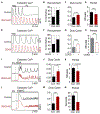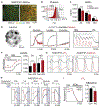CDK2 limits the highly energetic secretory program of mature β cells by restricting PEP cycle-dependent KATP channel closure
- PMID: 33503433
- PMCID: PMC7882066
- DOI: 10.1016/j.celrep.2021.108690
CDK2 limits the highly energetic secretory program of mature β cells by restricting PEP cycle-dependent KATP channel closure
Abstract
Hallmarks of mature β cells are restricted proliferation and a highly energetic secretory state. Paradoxically, cyclin-dependent kinase 2 (CDK2) is synthesized throughout adulthood, its cytosolic localization raising the likelihood of cell cycle-independent functions. In the absence of any changes in β cell mass, maturity, or proliferation, genetic deletion of Cdk2 in adult β cells enhanced insulin secretion from isolated islets and improved glucose tolerance in vivo. At the single β cell level, CDK2 restricts insulin secretion by increasing KATP conductance, raising the set point for membrane depolarization in response to activation of the phosphoenolpyruvate (PEP) cycle with mitochondrial fuels. In parallel with reduced β cell recruitment, CDK2 restricts oxidative glucose metabolism while promoting glucose-dependent amplification of insulin secretion. This study provides evidence of essential, non-canonical functions of CDK2 in the secretory pathways of quiescent β cells.
Keywords: CDK2; K(ATP) channel; PEP cycle; amplifying pathways; biosensor imaging; calcium; electrophysiology; insulin secretion; metabolic oscillations; β cell metabolism.
Copyright © 2021 The Author(s). Published by Elsevier Inc. All rights reserved.
Conflict of interest statement
Declaration of interests The authors declare no competing interests.
Figures







Similar articles
-
β-cell deletion of the PKm1 and PKm2 isoforms of pyruvate kinase in mice reveals their essential role as nutrient sensors for the KATP channel.Elife. 2022 Aug 23;11:e79422. doi: 10.7554/eLife.79422. Elife. 2022. PMID: 35997256 Free PMC article.
-
Pyruvate Kinase Controls Signal Strength in the Insulin Secretory Pathway.Cell Metab. 2020 Nov 3;32(5):736-750.e5. doi: 10.1016/j.cmet.2020.10.007. Cell Metab. 2020. PMID: 33147484 Free PMC article.
-
Glucose controls cytosolic Ca2+ and insulin secretion in mouse islets lacking adenosine triphosphate-sensitive K+ channels owing to a knockout of the pore-forming subunit Kir6.2.Endocrinology. 2009 Jan;150(1):33-45. doi: 10.1210/en.2008-0617. Epub 2008 Sep 11. Endocrinology. 2009. PMID: 18787024
-
Triggering and amplifying pathways of regulation of insulin secretion by glucose.Diabetes. 2000 Nov;49(11):1751-60. doi: 10.2337/diabetes.49.11.1751. Diabetes. 2000. PMID: 11078440 Review.
-
Shortcomings of current models of glucose-induced insulin secretion.Diabetes Obes Metab. 2009 Nov;11 Suppl 4:168-79. doi: 10.1111/j.1463-1326.2009.01109.x. Diabetes Obes Metab. 2009. PMID: 19817799 Review.
Cited by
-
Metabolic cycles and signals for insulin secretion.Cell Metab. 2022 Jul 5;34(7):947-968. doi: 10.1016/j.cmet.2022.06.003. Epub 2022 Jun 20. Cell Metab. 2022. PMID: 35728586 Free PMC article. Review.
-
Cyclin-dependent protein kinases and cell cycle regulation in biology and disease.Signal Transduct Target Ther. 2025 Jan 13;10(1):11. doi: 10.1038/s41392-024-02080-z. Signal Transduct Target Ther. 2025. PMID: 39800748 Free PMC article. Review.
-
LDHB contributes to the regulation of lactate levels and basal insulin secretion in human pancreatic β cells.Cell Rep. 2024 Apr 23;43(4):114047. doi: 10.1016/j.celrep.2024.114047. Epub 2024 Apr 11. Cell Rep. 2024. PMID: 38607916 Free PMC article.
-
Proteomics and Phosphoproteomics of Circulating Extracellular Vesicles Provide New Insights into Diabetes Pathobiology.Int J Mol Sci. 2022 May 21;23(10):5779. doi: 10.3390/ijms23105779. Int J Mol Sci. 2022. PMID: 35628588 Free PMC article.
-
BRSK2 in pancreatic β cells promotes hyperinsulinemia-coupled insulin resistance and its genetic variants are associated with human type 2 diabetes.J Mol Cell Biol. 2023 Nov 27;15(5):mjad033. doi: 10.1093/jmcb/mjad033. J Mol Cell Biol. 2023. PMID: 37188647 Free PMC article.
References
-
- Affourtit C, Alberts B, Barlow J, Carré JE, and Wynne AG (2018). Control of pancreatic β-cell bioenergetics. Biochem. Soc. Trans 46, 555–564. - PubMed
Publication types
MeSH terms
Substances
Grants and funding
LinkOut - more resources
Full Text Sources
Other Literature Sources
Molecular Biology Databases
Miscellaneous

